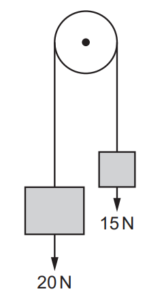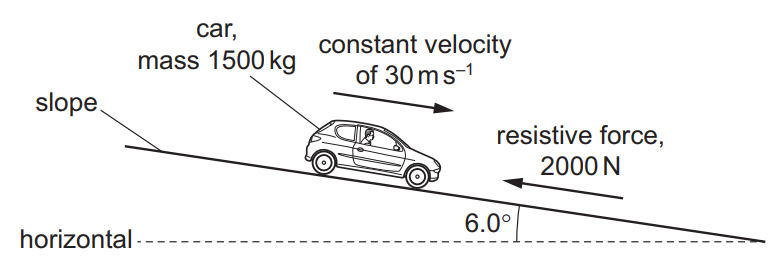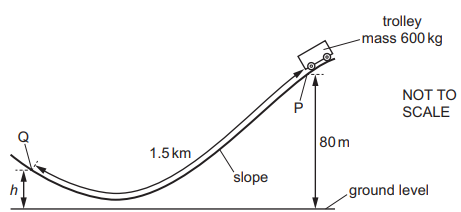Question
The total energy input \(E_{in}\) in a process is partly transferred to useful energy output U and partly transferred to energy that is wasted W.
What is the efficiency of the process?
A \(\frac{U}{E_{in}}\times 100\)%
B \(\frac{W}{E_{in}}\times 100\)%
C \(\frac{U}{W}\times 100\)%
D \(\frac{U + W}{E_{in}}\times 100\)%
Answer/Explanation
Ans: A
The efficiency is given as the total useful work divided by the energy supplied times 100, therefore,
Efficiency will be given as,
\(\frac{U}{E_{in}}\times 100\)%
Question
A rock of mass 40 kg is released from rest from a height of 20 m above the surface of a planet.
The rock has a kinetic energy of 32 kJ when it hits the surface of the planet. The planet does not have an atmosphere.
What is the weight of the rock on the surface of the planet?
A \(1.6\) N B \(390\) N C \(1.6\) kN D \(64\) kN
Answer/Explanation
Ans: C
According to the principle of conservation of energy, the kinetic energy at the surface will be equal to the potential energy at the initial height therefore we have,
PE = KE
mgh = 32 kJ
W = mg = (32000)/(h)
W = 32000/(20) = 1.6 kN
Question
A pulley of radius 0.40 m supports weights of 20 N and 15N by means of a thin string, as shown.

The weights are moved by slowly rotating the pulley clockwise through an angle of 60o. What is the increase in the total gravitational potential energy of the weights?
A 0.33 J B 2.0 J C 2.1 J D 15 J
Answer/Explanation
Ans:C
The rotation in the clockwise direction will move the 20 N upward and the 15 N weight downwards, therefore the increase in the gravitational potential energy will be given as,
PE = 20h – 15 h = 5h
where \(h = r \times \theta = 0.4\times 60\times \frac{3.14}{180} = 0.418 \) hence the increase in gravitational potential energy is given as,
PE = 5 x 0.418 = 2.1 J
Question
A car of mass 1500 kg travels at a constant velocity of 30 m s–1 down a slope. The slope is at an angle of 6.0o to the horizontal, as shown.

The magnitude of the total resistive force acting on the car is 2000 N. What is the power output of the car’s engine?
A 14 kW B 60 kW C 110 kW D 380 kW
Answer/Explanation
Ans:A
Since the car is moving with constant velocity, therefore the acceleration is zero, hence the force of resistance is equal to the downward force therefore,
\(F + mg \sin\theta – F_R = ma = 0 \)
\(F + mgsin\theta = 2000 N \)
\( F = 2000 – 1500\times9.8\times \sin6\)
\( F =463.43 N \)
The power output is given as,
\( P = Fv =463.43\times 30\)
P= 14 kW
Question
A trolley of mass 600 kg is initially at point P on a slope, at a height of 80 m above ground level,
as shown. The trolley is released from rest and moves along the slope, first coming to rest at
point Q, at height h above ground level.

The total distance PQ moved by the trolley along the slope is 1.5 km. A constant resistive force of
300N opposes the motion of the trolley on the slope.
What is h ?
A 3.5 m B 76 m C 79 m D 80 m
Answer/Explanation
Ans: A
According to the principle of conservation of energy, the potential energy of the trolley at the point Q is given as,
mgh = mgH – F d
h = H – Fd/mg
h = 80 – (300*1500)/( 600*9.8) = 3.5 m
Hence the option (A) is correct.